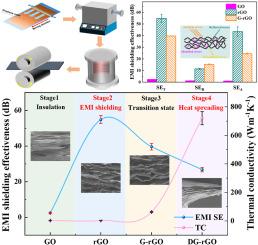Revealing synergistic relationship of thermal conduction and electromagnetic shielding of reduced graphene oxide film
IF 4.3
3区 材料科学
Q2 MATERIALS SCIENCE, MULTIDISCIPLINARY
引用次数: 0
Abstract
The present work tries to explore the evolution process of electro-magnetic interference shielding effectiveness and thermal conductivity of graphene film. There is an obvious promotion of electrical conductivity (from 3.51 × 10−3 to 769.20 S m−1) when GO is thermally reduced at 1100 °C. Correspondingly, the reduced graphene oxide (rGO) achieves the highest EMI shielding effectiveness (∼54.84 dB) at 1100 °C which is a synergetic result of electrical conductivity and porous structure with rich defects. The rGO is furtherly graphitized at 2800 °C (G-rGO) to repair the defects and C–C network and then mechanically rolled to a densified film with bulk density of 1.64 g cm−3 (called as DG-rGO). The thermal conductivity of DG-rGO membrane increases to 720.56 W m−1 K−1 after graphitization and rolling. Porous structure and defects are beneficial to higher EMI shielding effectiveness while dense structure without defects lead to higher thermal conductivity. Therefore, the highest EMI shielding effectiveness and thermal conductivity cannot be obtained simultaneously. A reference range is provided to fulfill the request of EMI shielding and thermal conductivity.

揭示还原氧化石墨烯薄膜热传导与电磁屏蔽的协同关系
本研究试图探索石墨烯薄膜的电磁干扰屏蔽效果和热导率的演变过程。在 1100 °C 下对 GO 进行热还原时,导电率明显提高(从 3.51 × 10-3 提高到 769.20 S m-1)。相应地,还原氧化石墨烯(rGO)在 1100 ℃ 时达到了最高的电磁干扰屏蔽效果(54.84 dB),这是导电性和富含缺陷的多孔结构协同作用的结果。rGO 在 2800 ℃ 时进一步石墨化(G-rGO)以修复缺陷和 C-C 网络,然后机械轧制成体积密度为 1.64 g cm-3 的致密薄膜(称为 DG-rGO)。经过石墨化和滚压后,DG-rGO 膜的热导率增加到 720.56 W m-1 K-1。多孔结构和缺陷有利于提高 EMI 屏蔽效果,而无缺陷的致密结构则会导致更高的热导率。因此,不可能同时获得最高的 EMI 屏蔽效果和热导率。为满足 EMI 屏蔽和热导率的要求,我们提供了一个参考范围。
本文章由计算机程序翻译,如有差异,请以英文原文为准。
求助全文
约1分钟内获得全文
求助全文
来源期刊

Materials Chemistry and Physics
工程技术-材料科学:综合
CiteScore
8.70
自引率
4.30%
发文量
1515
审稿时长
69 days
期刊介绍:
Materials Chemistry and Physics is devoted to short communications, full-length research papers and feature articles on interrelationships among structure, properties, processing and performance of materials. The Editors welcome manuscripts on thin films, surface and interface science, materials degradation and reliability, metallurgy, semiconductors and optoelectronic materials, fine ceramics, magnetics, superconductors, specialty polymers, nano-materials and composite materials.
 求助内容:
求助内容: 应助结果提醒方式:
应助结果提醒方式:


